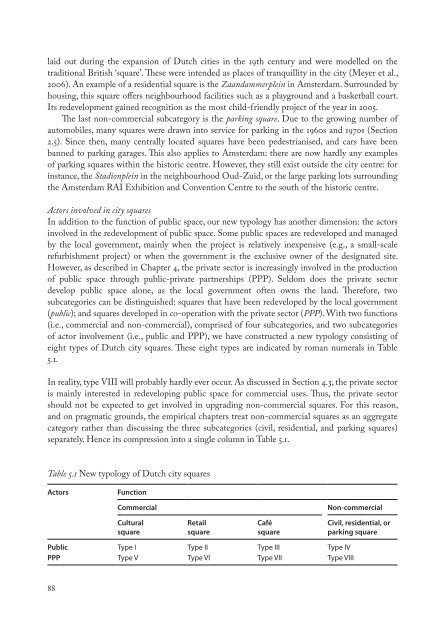Changing public space
Changing public space
Changing public space
Create successful ePaper yourself
Turn your PDF publications into a flip-book with our unique Google optimized e-Paper software.
laid out during the expansion of Dutch cities in the 19th century and were modelled on the<br />
traditional British ‘square’. These were intended as places of tranquillity in the city (Meyer et al.,<br />
2006). An example of a residential square is the Zaandammerplein in Amsterdam. Surrounded by<br />
housing, this square offers neighbourhood facilities such as a playground and a basketball court.<br />
Its redevelopment gained recognition as the most child-friendly project of the year in 2005.<br />
The last non-commercial subcategory is the parking square. Due to the growing number of<br />
automobiles, many squares were drawn into service for parking in the 1960s and 1970s (Section<br />
2.5). Since then, many centrally located squares have been pedestrianised, and cars have been<br />
banned to parking garages. This also applies to Amsterdam: there are now hardly any examples<br />
of parking squares within the historic centre. However, they still exist outside the city centre: for<br />
instance, the Stadionplein in the neighbourhood Oud-Zuid, or the large parking lots surrounding<br />
the Amsterdam RAI Exhibition and Convention Centre to the south of the historic centre.<br />
Actors involved in city squares<br />
In addition to the function of <strong>public</strong> <strong>space</strong>, our new typology has another dimension: the actors<br />
involved in the redevelopment of <strong>public</strong> <strong>space</strong>. Some <strong>public</strong> <strong>space</strong>s are redeveloped and managed<br />
by the local government, mainly when the project is relatively inexpensive (e.g., a small-scale<br />
refurbishment project) or when the government is the exclusive owner of the designated site.<br />
However, as described in Chapter 4, the private sector is increasingly involved in the production<br />
of <strong>public</strong> <strong>space</strong> through <strong>public</strong>-private partnerships (PPP). Seldom does the private sector<br />
develop <strong>public</strong> <strong>space</strong> alone, as the local government often owns the land. Therefore, two<br />
subcategories can be distinguished: squares that have been redeveloped by the local government<br />
(<strong>public</strong>); and squares developed in co-operation with the private sector (PPP). With two functions<br />
(i.e., commercial and non-commercial), comprised of four subcategories, and two subcategories<br />
of actor involvement (i.e., <strong>public</strong> and PPP), we have constructed a new typology consisting of<br />
eight types of Dutch city squares. These eight types are indicated by roman numerals in Table<br />
5.1.<br />
In reality, type VIII will probably hardly ever occur. As discussed in Section 4.3, the private sector<br />
is mainly interested in redeveloping <strong>public</strong> <strong>space</strong> for commercial uses. Thus, the private sector<br />
should not be expected to get involved in upgrading non-commercial squares. For this reason,<br />
and on pragmatic grounds, the empirical chapters treat non-commercial squares as an aggregate<br />
category rather than discussing the three subcategories (civil, residential, and parking squares)<br />
separately. Hence its compression into a single column in Table 5.1.<br />
Table 5.1 New typology of Dutch city squares<br />
Actors<br />
Function<br />
Commercial<br />
Non-commercial<br />
Cultural<br />
square<br />
Retail<br />
square<br />
Café<br />
square<br />
Civil, residential, or<br />
parking square<br />
Public Type I Type II Type III Type IV<br />
PPP Type V Type VI Type VII Type VIII<br />
88




